An ancient rainforest in BC’s interior is at risk of disappearing after decades of logging
Funding for this story was made possible by a grant from Geos Institute.
An ancient rainforest, nestled at the northern edge of the Rocky Mountains, has flourished for thousands of years. But this isn’t just any forest. Towering with western red cedars, western hemlock, spruce, and subalpine fir, British Columbia’s inland temperate rainforest has all the hallmarks of a coastal rainforest, yet it is nearly 1,000 km (621 miles) inland. It’s one of the rarest ecosystems on the planet.
Stretching for more than 200,000 hectares along the Upper Fraser Watershed, this diverse and ecologically sensitive forest is home to a vast array of flora and fauna. The interior cedar hemlock ecozone is not only home to thousand year-old western red cedars, but also mountain hemlock, Engelmann spruce, and subalpine fir. These damp, surprisingly lush forests support habitat for black bears, grizzlies, wolverines, pileated woodpeckers, owls, and many other animal species. But this trove of biodiversity that few people know about is now under threat from recent clear-cut logging.
Only 9 percent of BC’s inland rainforest has been designated as protected areas or parks by the provincial government, leaving more than three quarters of the remaining land open to clear-cut logging, which has removed more than a quarter of all the old-growth cedar and hemlock over the past half century. There is no end in sight.
“Globally, primary forests [forests that have never been industrially harvested] are in decline,” says Michelle Connolly, a forest ecologist and executive director of Conservation North, a Prince George-based non-profit dedicated to protecting old growth and primary forests in interior BC.
“They are becoming more and more rare,” she says. “In the Central Interior we have some very special pockets of forest that are under threat from industrial logging and road building.”
About an hour outside Prince George, Connolly pulls off the Fraser Flats logging road just short of a massive clear-cut site to highlight what the forest looks like before it’s harvested.
One hundred-foot cedars and the occasional spruce dominate the canopy as we gingerly move our way through thick, prickly devil’s club. It’s a scene that has remained unchanged for thousands of years.
A primary forest is one that has never been industrialized in the past. They’re important to conserve because they’re irreplaceable.
The lush undergrowth and massive trees so far inland are the result of up to 1,200 millimeters of annual precipitation. As moisture drifts inland, it falls on the western slopes of the Rocky Mountain Trench. The adjacent mountains create an area known as an “interior wet belt,” allowing rare lichens such as greater green moon lichen and toothed peat moss to flourish here.
This dense vegetation creates important habitat for a great number of wildlife, including the endangered mountain caribou. Across British Columbia, mountain caribou have experienced a nearly 40 percent decline since 1995—largely due to habitat loss from industrial logging. However, for now, the Hart Range and Upper Fraser herds extend north of the Robson Valley into the northern Rockies. But with logging ramping up in these forests, the mountain caribou, like many other old forest-dependent species, are under extreme pressure from habitat depletion.
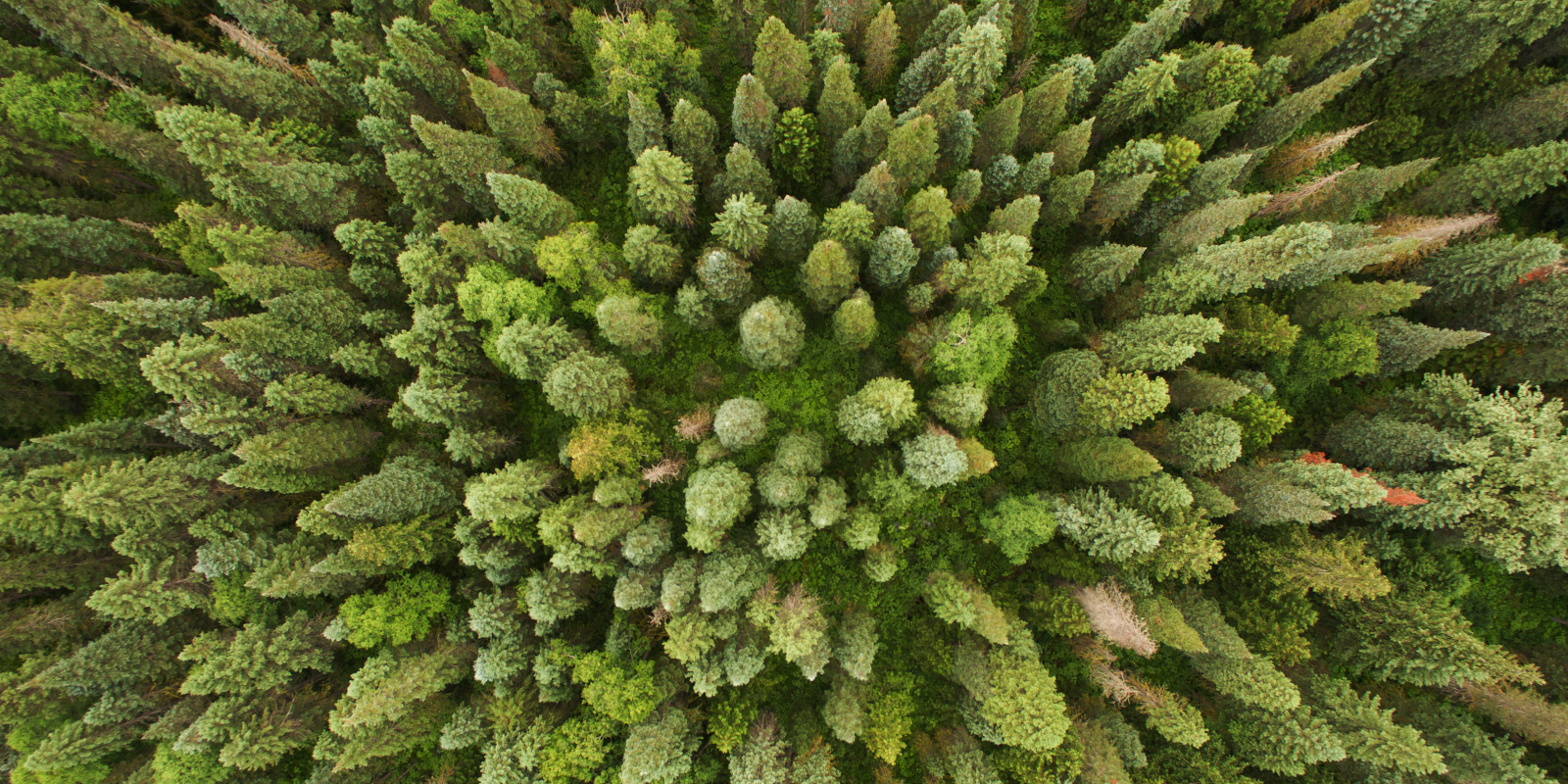
“We live in a place that gets orographic precipitation [rain and snow produced by moist clouds moving across mountain ranges], often referred to as the inland rainforest,” Connolly explains. “It stretches south along the Rocky Mountain Trench. We’re in the wettest part of the rainforest right now. In an old growth forest you will see living trees, dead trees that are standing, dead trees that have fallen over, and young trees. All of those elements provide the structural complexity wildlife need. You rarely see those elements together in industrially managed forests around here.”
That variety is part of what makes this place so unique, a dense network of biodiversity that is only possible with habitat this old and undisturbed.
Connolly continues, “A primary forest is one that has never been industrialized in the past. They’re important to conserve because they’re irreplaceable. Even if you get an insect outbreak that kills trees in an old forest it’s still important to protect. Humans cannot replicate the complexity created in natural forests by disturbances like insects or fire.”
But as timber shortages across the province mount and dozens of sawmills curtail their operations, leaving hundreds out of work, the inland rainforest is becoming prime territory for logging companies struggling to keep sawmills flush with new trees.
Over the past 15 years, sawmills in BC’s interior have been sustaining their operations by harvesting mountain pine beetle-stricken timber from vast swaths of land. That timber is all but gone and major players in the logging industry, including Canfor and BC Timber Sales, are now setting their sights on these old-growth stands of spruce, cedar, and hemlock.
Much of it will be milled into everyday lumber like two-by-fours and two-by-sixes. But as the Boreal Bioenergy plant in McBride, BC inches closer to a start-up date in late 2020, the industry is also looking to profit from waste wood: much of the excess old-growth timber will be made into industrial wood pellets destined for “green” power plants overseas.
A natural emergency
Global ecosystems are declining at an unprecedented rate across the globe due to human activity and climate change. A recent report from the Intergovernmental Science-Policy Platform on Biodiversity and Ecosystem Services (IPBES) sounded the alarm that around 1 million species are facing the threat of extinction over the coming decades. Though BC’s current government has set bold targets for reducing its climate impact, clear-cut logging in the inland rainforest continues. This begs the question: does other action on climate give the province license to destroy one of the last strongholds of biodiversity on the planet?
Former agrologist turned organic farmer Andrew Adams doesn’t think so.
“In terms of biodiversity I think of these areas as giant seed banks,” says Adams. “As the climate changes, we have seed banks for agriculture because we know things are going to fail. As ecosystems collapse it’s going to be places like [the inland rainforest] that we can pull from the abundant species to start repopulating and fixing the problems we’ve already caused. There are so many species out here that we haven’t identified yet.”
Adams accompanies Connolly as we make our way through a lush section of immense cedar and hemlock not far from his home in Newlands, BC. This former logging community that once boasted 1,600 residents is now home to 12 people. As we walk, Adams talks about his days working in the forestry industry and the frustration he felt in trying to protect some of the more sensitive areas of these forests.
“This biggest thing for me was that I lost faith in professional designation,” Adams says. “The whole professional reliance model is so, so flawed.”
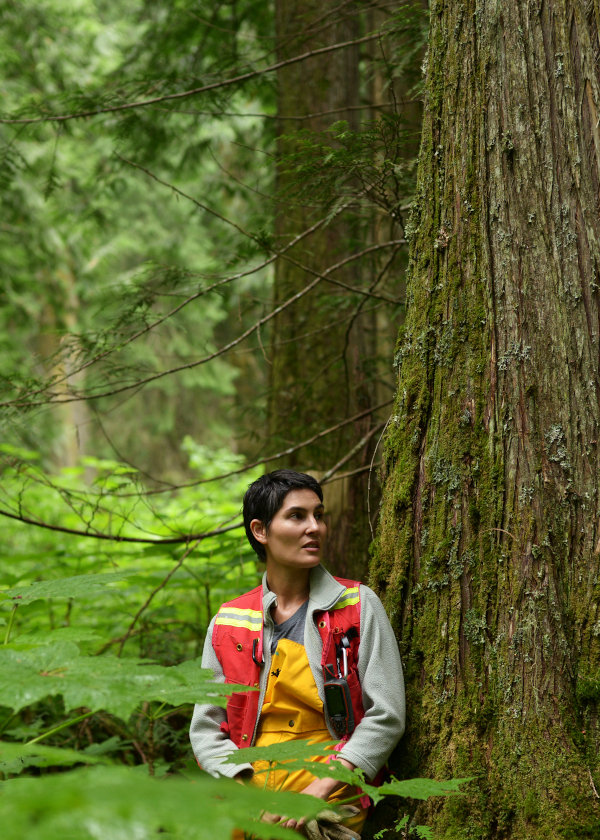
Professional reliance in BC refers to a system of environmental management and assessment review set up in the early 2000’s that allows government and industry to outsource data collection and scientific reporting to qualified professionals with biology or engineering backgrounds, usually associated with an environmental consulting firm.
On occasion over the past 20 years conflict of interest issues have surfaced when companies responsible for hiring these qualified professionals shop around for someone who will report what they want them to report to ensure business as usual continues.
Adams says he routinely raised issues about forestry practices to his superiors thinking they would take them seriously and act to reduce impacts on the ecology of this unique forest. His appeals fell on deaf ears.
His focus was to identify which ecosystems and plant species were at risk. Adams felt like he was helping protect the inland rainforest by mapping out where logging shouldn’t take place, but he found that logging operations would clear-cut those areas regardless of his recommendations.
“The same areas would have machine tracks going right through the ribbon line that [designated] a machine-free zone,” he says. “It was about that time that I realized the professional reliance model was gone.
“I feel like the general public and the people doing the logging themselves are kind of ignorant to what they’re cutting down and removing, seeing a forest for just the standing timber or lumber and the dollar signs that come out of it and not seeing the ecosystem services that come from these areas.”
Biodiversity hotspots
The collection of biodiversity within the inland rainforest is one of the rarest on the planet; the only other examples of similar wet forests deep in the interior of a continent can be found in Southern and Eastern Russia. Although portions of BC’s inland rainforest have been studied for years, scientists are still discovering new species of plants, fungi, and lichens.
Dr. Darwyn Coxson, a professor of Ecosystem Science and Management at the University of Northern British Columbia, has led several expeditions to identify and catalogue previously undiscovered species in the hopes of determining where the major biodiversity hotspots are.
“When we visited these areas, we found both high biodiversity ecosystems that had not been previously identified, as well as individual species new to science,” says Coxson. “Certainly, we’ve come to recognize that the inland rainforest is a very significant repository for biodiversity in western North America, particularly the wetter sites.”
BC Conservation Data Centre, a provincial database that catalogues at-risk species and major ecosystems throughout the province, has historically limited its surveys of species of flora and fauna to areas accessible by roads and waterways.
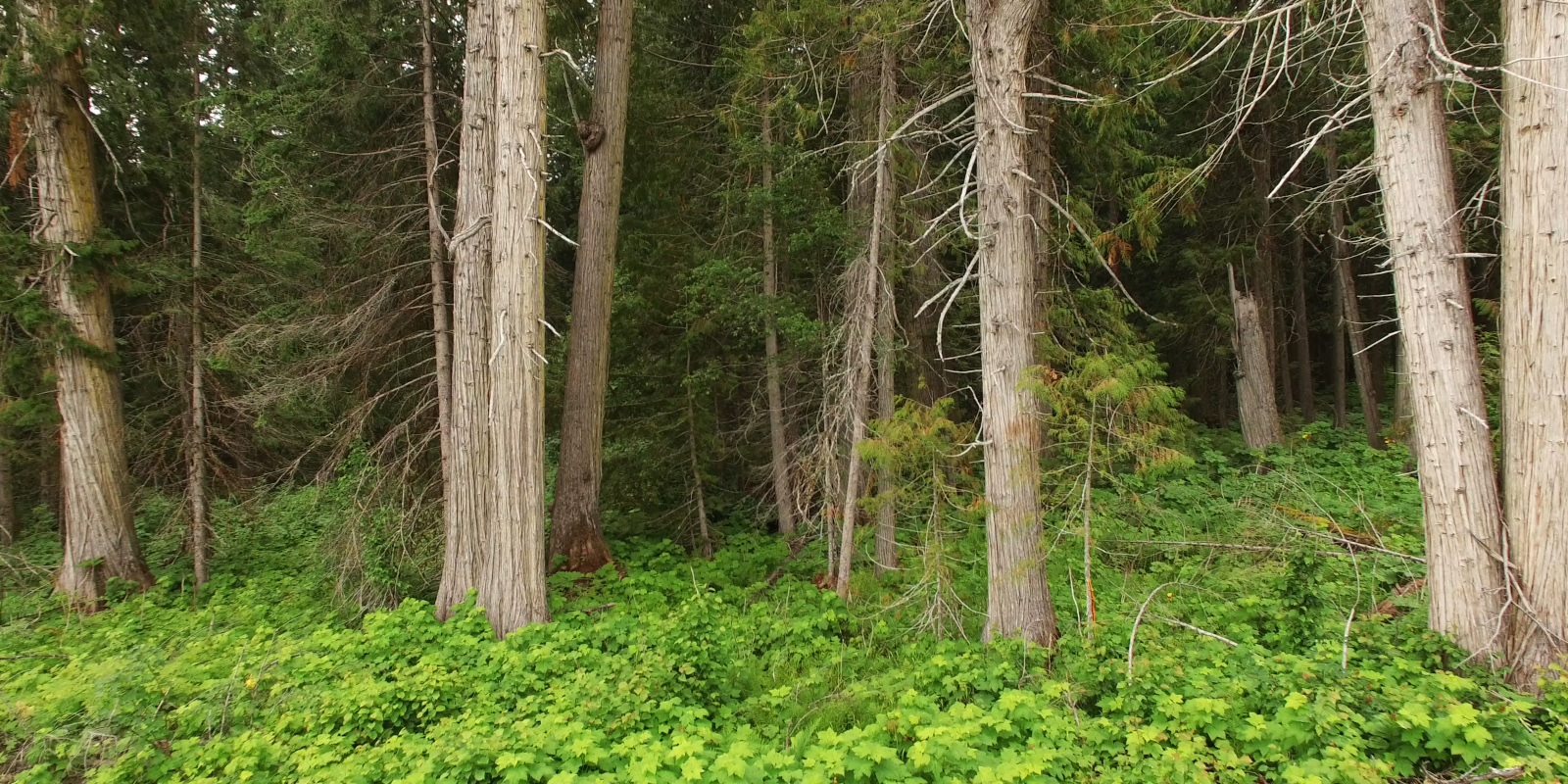
But Coxson says that once he and his team ventured deep into the inland rainforest, they began to discover scores of new plant and lichen species. Among them are spotted joe-pye weed, northern white rush, toothed sphagnum, and greater green moon lichen. These rare species are an integral part of a complex ecosystem found nowhere else on the planet. Because logging has scarred these old-growth forest for decades, many unknown species may be lost for good.
“If you [could] step back 100 years, the landscapes of the Upper Fraser River Watershed and the Upper Columbia River Watershed would have been dominated by old forests,” says Coxson.
“There is good data to suggest that historically that number would have been about 80 percent, he says. “As a consequence, many of the plants and animals of the inland rainforest are highly adapted to and require old-forest conditions. Changes that have come about in the last 40 to 50 years have dramatically altered that distribution of old forests on the landscape.”
We need to identify where the remaining important habitat is, for example, where the largest remaining old forest patches are, and we need a cessation of logging in those areas.
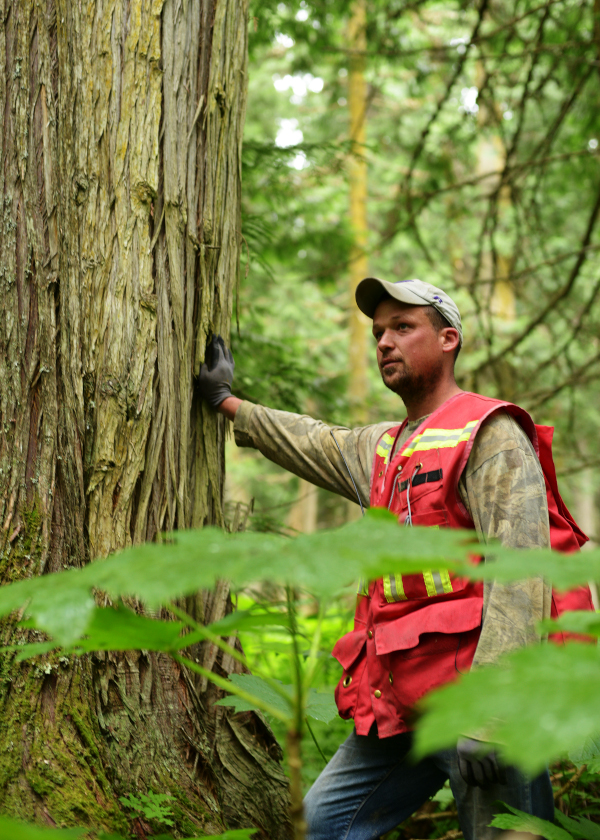
Over the last few years Coxson and his team of researchers have catalogued more than 2,400 different species of plants and lichen. A major focus for Coxson and his team has been to figure out what impacts road building and clear-cutting are having on forest-dependant plants and animals. As old-growth forests are reduced to a fractured landscape of small, isolated patches of land, continued ecological function becomes more difficult.
“It’s sort of a perfect storm unfortunately in British Columbia right now for protection of old forests,” says Coxson.
Climate change brought the destructive mountain pine beetle to BC’s northern forests, and the mills adapted to cut and utilize that damaged wood. But now those operations have reached their end and timber companies are turning their attention to the wet inland rainforest to avoid mill closures and layoffs. But is the tradeoff of a few hundred jobs worth the destruction of an ecosystem that takes hundreds of years to establish? Throughout the province, dependence on logging for economic growth makes it difficult for these small communities and the provincial government to adjust to a timber supply that’s truly sustainable in the long term.
“Several things need to be done,” Coxson says. “We need to identify where the remaining important habitat is, for example, where the largest remaining old forest patches are, and we need a cessation of logging in those areas. Many plants and animals are literally hanging on by their fingernails in some of these last patches. Mountain caribou are a prime example. Time is of the essence; we have the knowledge of where these remaining old forests are, but we need to have a real change in our forest management practices so that we aren’t continuing to fragment the remaining old forest.”
Critical sites important to First Nations
In 2016, the BC government designated a section of the inland rainforest as a new provincial park and protected area. The Ancient Forest/Chun T’oh Whudujut Provincial Park is an 11,190-hectare tract of land within the traditional territory of the Lheidli T’enneh, an Indigenous First Nation that controls more than 4.3 million hectares of territory in and around Prince George.
“The rainforest represents a deep connection to the land for his people, one that can always link them to their ancestors going back thousands of years,” says Clayton Pountney, Chief Councillor of the Lheidli T’enneh.
Pountney has a cabin just north of the ancient forest, an area where his great-grandfather hunted and trapped. His family has a long history here and a deep connection to the lush thickets in these forests.
Over the years, Pountney says, many Culturally Modified Trees (CMTs) have been found in the area—direct evidence that the Lheidli T’enneh people have traditionally made use of these trees for thousands of years. This includes trail marking, bark stripping, and canoe making. Pountney says once areas with CMTs are found they are usually protected from logging. But in stark contrast, 40 or 50 years ago logging companies would cut down anything in their path, regardless of its cultural or ecological significance.
“At least now [forestry companies] are working with us instead of against us,” he says, “but I think we’ve lost a lot historically with CMTs and some cultural spots because they’ve just gone in there and bulldozed right through.”
Pountney says the nation’s leadership over the years have made leaps and bounds regarding the Lheidli T’enneh’s rights to the land and what happens on it. One example is the Lheidli T’enneh Land Code established through the Federal First Nations Land Management Act, which allows the nation to determine fundamental laws and rules in the administration of natural resources within their territories. “Now we’re living in a pretty good time where our say does mean a lot,” he says.
Forestry in general is the biggest single source of greenhouse gas emissions in the province.
Although there have been some tense relationships with the logging industry in the past, these days more companies seem willing to listen to the Lheidli T’enneh’s concerns when it comes to a sensitive area of the forest they want to preserve.
“We’re working side-by-side with industry,” Pountney says. “As long as things are identified, they know we have certain areas, like a sacred area. The Ancient Forest has a big circle around it, no one is going in there.”
Though, as logging in some areas of the forest continues, Pountney says it’s better to work with industry to find a sustainable path forward and that his council is trying to drive industry by working alongside them.
“Having open communication and a relationship makes it a lot easier for us to assert ourselves and say, ‘no, we don’t want you over here, but we can work with you in this area and we’d like to sustainably plan and go from there.’ So, we want to be working alongside them instead of being constantly working against them.”
But still, the logging continues.
Old-growth forests and climate change
As the old-growth forest is logged it not only displaces rare plant species and animals, but it destabilizes the carbon storage that exists within the trees, sequestering carbon over hundreds, and even thousands of years.
In a new report written by Dr. Jim Pojar, a forest ecologist based in Smithers, BC, for more than 40 years, forestry is one of the most intensive emitters of carbon dioxide on the planet. According to Pojar’s findings, logging primary old-growth forests and replacing them with managed plantations can reduce carbon storage by 40-50 percent.
“Forestry in general is the biggest single source of greenhouse gas emissions (GHG) in the province,” says Pojar. “If we are going to reduce greenhouse gas emissions immediately, forestry has to be part of the solution. The benefits of carbon storage in existing intact, natural forests are immediate: the carbon is there and it’s being stored. But when you log a forest, the losses take many decades or centuries to recoup, and the emissions increase after that logging.”
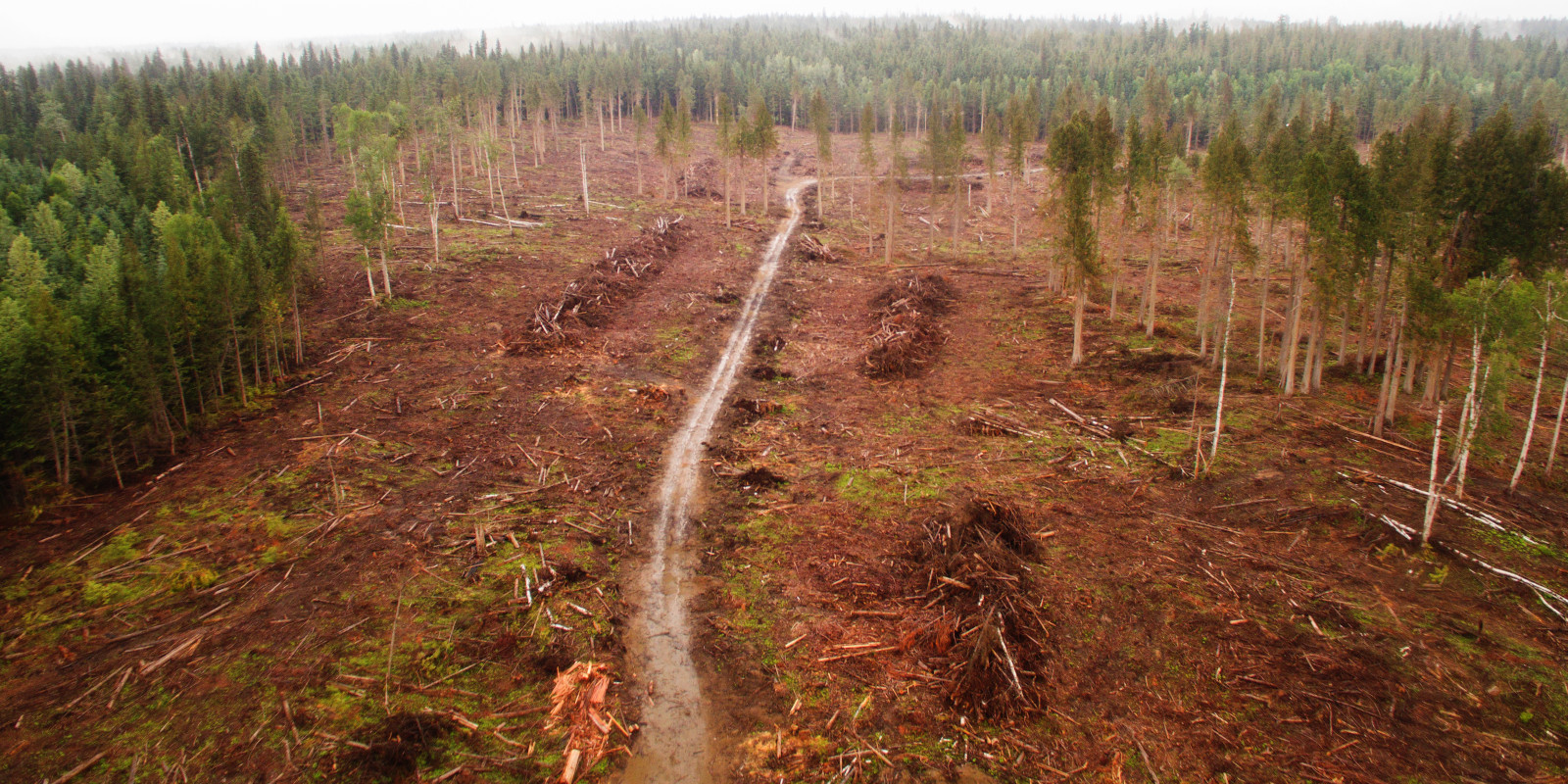
Pojar stresses that to truly exercise carbon stewardship in forestry, British Columbia needs to preserve and protect more of these old growth, carbon-rich forests, especially those found in the wet regions of the province. Protections help ensure these forests remain decades into the future and face fewer natural disturbances such as wildfires, insect outbreaks, and blowdowns. However, he fears business as usual in the interior old-growth will persist.
“The inland temperate rainforest in the Rocky Mountain Trench and Columbia Mountains to the south is indeed a globally rare and threatened ecological zone—especially its old-growth forests,” says Pojar. “The remaining old-growth stands are on the chopping block and continue to fall to excessive, wasteful, and carbon-hostile clear-cutting.”
In a statement provided by Canfor, one of the major tenure holders in BC’s inland rainforest, Michelle Ward, Director of Corporate Communications, says the company doesn’t typically target specific species of trees and is operating in compliance with BC forestry policies.
“All harvesting is done in accordance with the Forest and Range Practices Act,” Ward says in the statement. “The primary species logged are spruce, balsam, and pine, and these trees are fully utilized to produce saw logs and pulp logs. All residual products from the manufacturing process such as bark, sawdust, shavings, and wood chips are used to generate energy to power our facilities or converted into wood pellets as a renewable energy source. As a standard practice, deciduous trees are usually avoided and retained on the site to contribute to biodiversity.”
Pushing for legal protection of old-growth
Although the BC government took steps in July 2019 to protect a mere 54 of BC’s oldest and largest individual trees, (mostly in coastal regions), it has done little to address the issue of clear-cut logging in the inland rainforest, which may increase as pressure mounts to harvest more timber and boost struggling sawmills.
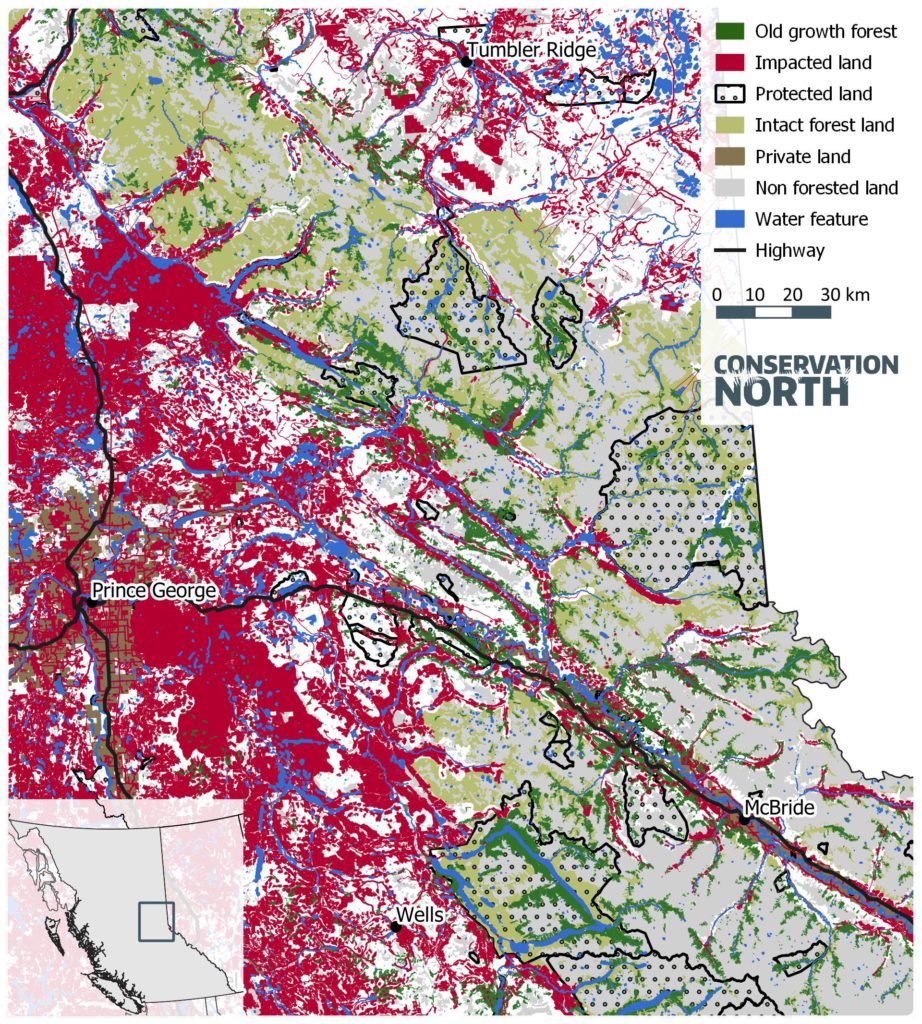
In June, Connolly and dozens of Conservation North supporters rallied outside the office of MLA Shirley Bond, who represents Prince George in the BC legislature. The demonstration brought attention to the logging of inland old-growth and sought Bond’s support in developing a system of legal reserves for the remaining interior old-growth forests.
Connolly says Conservation North came into being after its founders (all women) became exhausted with the treatment of their local landscapes and rampant logging over the past fifty years. Many members of the organization live in and around the inland rainforest and want to ensure it remains intact for generations to come.
“We demand legal protection for our remaining old growth and primary forests, particularly forests that are older than 250 years old,” Connlly says. “We want a system of reserves for forests that are particularly vulnerable to industrial logging. Second, we want a transition away from harvesting these forests and into doing more with second-growth forests.”
“This is our home and we’re here for the long haul. We demand that these forests be too.”
Article, video, and all photographs by Daniel Mesec.
CORRECTION, August 26, 2019: The annual precipitation in BC’s inland rainforest is up to 1,200 millimetres annually, not 400 millimetres, as previously published. Also, Michelle Connolly’s name was misspelled in several instances and has been corrected.
.
Daniel Mesec has lived in BC’s Central Interior for nearly a decade and as a photojournalist has covered everything from Indigenous land rights to salmon runs on the Skeena to filming wild goats in the Stikine Canyon. He lives in Smithers with his partner Gen and his wild-dog Tosca. Follow him on Instagram at @danmesec.
.
Funding for this article was provided by Geos Institute, which provides policy makers and land managers with scientific information and management guidance to sustain temperate forests in changing climate conditions.
If you appreciate great journalism like this, please consider becoming a supporting reader of Cascadia Magazine. We can’t continue this kind of reporting without your help–please visit our donate page to make a contribution today. Thank you.
